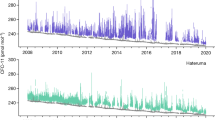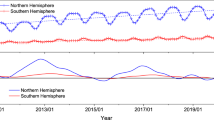Abstract
The consumption of methyl chloroform (1,1,1-trichloroethane), an industrial solvent, has been banned by the 1987 Montreal Protocol because of its ozone-depleting potential. During the 1990s, global emissions have decreased substantially and, since 1999, near-zero emissions have been estimated for Europe and the United States. Here we present measurements of methyl chloroform that are inconsistent with the assumption of small emissions. Using a tracer transport model, we estimate that European emissions were greater than 20 Gg in 2000. Although these emissions are not significant for stratospheric ozone depletion, they have important implications for estimates of global tropospheric hydroxyl radical (OH) concentrations, deduced from measurements of methyl chloroform. Ongoing emissions therefore cast doubt upon recent reports of a strong and unexpected negative trend in OH during the 1990s and a previously calculated higher OH abundance in the Southern Hemisphere compared to the Northern Hemisphere.
This is a preview of subscription content, access via your institution
Access options
Subscribe to this journal
Receive 51 print issues and online access
$199.00 per year
only $3.90 per issue
Buy this article
- Purchase on Springer Link
- Instant access to full article PDF
Prices may be subject to local taxes which are calculated during checkout




Similar content being viewed by others
References
Midgley, P. M. & McCulloch, A. The production and global distribution of emissions to the atmosphere of 1,1,1-trichloroethane (methyl chloroform). Atmos. Environ. 29, 1601–1608 (1995)
Prinn, R. G. et al. A history of chemically and radiatively important gases in air deduced from ALE/GAGE/AGAGE. J. Geophys. Res. 105, 17751–17792 (2000)
McCulloch, A. & Midgley, P. M. The history of methyl chloroform emissions: 1951–2000. Atmos. Environ. 35, 5311–5319 (2001)
UNEP (United Nations Environment Programme). Production and Consumption of Ozone-depleting Substances under the Montreal Protocol: 1986–2000 (UNEP, Nairobi, Kenya, 2002); available at http://www.unep.org/ozone/15-year-data-report.pdf.
Singh, H. B. Preliminary estimation of average tropospheric HO concentrations in the Northern and Southern Hemisphere. Geophys. Res. Lett. 4, 453–456 (1977)
Prinn, R. G. et al. Atmospheric trends in methylchloroform and the global average for the hydroxyl radical. Science 238, 935–950 (1987)
Prinn, R. G. et al. Atmospheric trends and lifetime of CH3CCl3 and global OH concentrations. Science 269, 187–192 (1995)
Prinn, R. G. et al. Evidence for substantial variations of atmospheric hydroxyl radicals in the past two decades. Science 229, 1882–1888 (2001)
Krol, M., van Leeuwen, P. J. & Lelieveld, J. Global OH trend inferred from methylchloroform measurements. J. Geophys. Res. 103, 10697–10711 (1998)
Krol, M. & Lelieveld, J. Can the variability in tropospheric OH be deduced from measurements of 1,1,1-trichloroethane (methyl chloroform)? J. Geophys. Res. (in the press)
Montzka, S. A. et al. New observational constraints for atmospheric hydroxyl on global and hemispheric scales. Science 288, 500–503 (2000)
Hauglustaine, D. A. et al. MOZART, a global chemical transport model for ozone and related chemical tracers 2. Model results and evaluation. J. Geophys. Res. 103, 28291–28335 (1998)
Houweling, S., Dentener, F. & Lelieveld, J. The impact of nonmethane hydrocarbon compounds on tropospheric photochemistry. J. Geophys. Res. 103, 10673–10696 (1998)
Wang, Y. & Jacob, J. D. Anthropogenic forcing on tropospheric ozone and OH since preindustrial times. J. Geophys. Res. 103, 31123–31135 (1998)
Spivakovsky, et al. Three-dimensional climatological distribution of tropospheric OH: Update and evaluation. J. Geophys. Res. 105, 8931–8980 (2000)
Ryall, D. B., Derwent, R. G., Manning, A. J., Simmonds, P. G. & O'Doherty, S. Estimating source regions of European emissions of trace gases from observations at Mace Head. Atmos. Environ. 35, 2507–2523 (2001)
Lelieveld, J. et al. Global air pollution crossroads over the Mediterranean. Science 298, 794–799 (2002)
Brenninkmeijer, C. A. M. et al. CARIBIC - Civil aircraft for global measurement of trace gases and aerosols in the tropopause region. J. Atmos. Ocean. Technol. 16, 1373–1383 (1999)
Butler, J. H. et al. A record of atmospheric halocarbons during the twentieth century from polar firn air. Nature 399, 749–755 (1999)
Dziura, E. L., Molseed, A. C. & Kramlich, J. C. Thermal destruction behavior of selected waste compounds under short-time, high quench rate conditions. Environ. Eng. Sci. 14, 33–42 (1997)
Lelieveld, J., Peters, W., Dentener, F. J. & Krol, M. Stability of tropospheric hydroxyl chemistry. J. Geophys. Res. 107, 10.1029/2002JD002272 (2002)
Dentener, F., van Weele, M., Krol, M., Houweling, S. & van Velthoven, P. Trends and inter-annual variability of methane emissions derived from 1979–1993 global CTM simulations. Atmos. Chem. Phys. Discuss. 2, 249–287 (2002)
Oram, D. E., Reeves, C. E., Penkett, S. A. & Fraser, P. J. Measurements of HCFC-142b and HCFC-141b in the Cape Grim air archive: 1978–1993. Geophys. Res. Lett. 22, 2741–2744 (1995)
Sturges, W. T. et al. Methyl bromide, other brominated methanes, and methyl iodide in polar firn air. J. Geophys. Res. 106, 1595–1606 (2001)
Gerbig, C., Schmitgen, S., Kley, D. & Volz-Thomas, A. An improved fast-response vacuum-UV resonance fluorescence CO instrument. J. Geophys. Res. 104, 1699–1704 (1999)
Scheeren, H. A., Lelieveld, J., de Gouw, J. A., van der Veen, C. & Fischer, H. Methyl chloride and other chlorocarbons in polluted air during INDOEX. J. Geophys. Res. 107, 10.1029/2001JD001121 (2002)
Berkvens, P. J. F., Botchev, M. A., Lioen, W. M. & Verwer, J. G. A zooming technique for wind transport of air pollution. Report MAS-R9921 (CWI, Amsterdam, 1999).
Krol, M. C., Peters, W., Berkvens, P. J. F. & Botchev, M. A. A new algorithm for two-way nesting in global models: principles and applications. Proc. 2nd Int. Conf. Air Pollution Modelling and Simulation, April 9–12, 2001, Champs-sur-Marne (ed. Sportisse, B.) 225–235 (Springer, Berlin, Heidelberg and New York, 2002)
Krol, M., van Leeuwen, P. J. & Lelieveld, J. Comment on “Global OH trend inferred from methylchloroform measurements” by Maarten Krol et al.– Reply. J. Geophys. Res. 106, 23159–23164 (2001)
Olivier, J. G. J. & Berdowski, J. J. M. in The Climate System (eds Berdowski, J., Guicherit, R. & Heij, B. J.) 33–78 (Balkema/Swets & Zeitlinger, Lisse, 2001)
Lelieveld, J. & Dentener, F. J. What controls tropospheric ozone? J. Geophys. Res. 105, 3531–3551 (2000)
Peters, W., Krol, M., Dentener, F. & Lelieveld, J. Identification of an El Nino-Southern Oscillation signal in a multiyear global simulation of tropospheric ozone. J. Geophys. Res. 106, 10389–10402 (2001)
Jeuken, A., Veefkind, J. P., Dentener, F., Metzger, S. & Gonzalez, C. R. Simulation of the aerosol optical depth over Europe for August 1997 and a comparison with observations. J. Geophys. Res. 106, 28295–28311 (2001)
Acknowledgements
Assistance from E. Atlas and S. Montzka in instrumental design and calibrations is gratefully acknowledged. R.G. Prinn and colleagues provided the AGAGE MCF and CO data at Mace Head. We thank F. J. Dentener for comments and help with the implementation of the EDGAR 3.2 CO emissions, which were provided by J. Olivier. We also thank C. v.d. Veen and R. Hofmann for experimental assistance. EXPORT CO data were provided by H. Barjat and J. Kent of the UK Met Office using an instrument on loan from the Institut für Chemie und Dynamik der Geosphaere Forschungszentrum Jülich. EXPORT was funded by the UK Natural Environment Research Council (NERC) with additional funds from the UK Department of Environment, Food and Rural Affairs (DEFRA) and the UK Met Office. M.K. is supported by the Space Research Organisation Netherlands (SRON). V.G. is supported by a scientific cooperation between MPG and CNRS.
Author information
Authors and Affiliations
Corresponding author
Ethics declarations
Competing interests
The authors declare that they have no competing financial interests.
Rights and permissions
About this article
Cite this article
Krol, M., Lelieveld, J., Oram, D. et al. Continuing emissions of methyl chloroform from Europe. Nature 421, 131–135 (2003). https://doi.org/10.1038/nature01311
Received:
Accepted:
Issue Date:
DOI: https://doi.org/10.1038/nature01311
This article is cited by
Comments
By submitting a comment you agree to abide by our Terms and Community Guidelines. If you find something abusive or that does not comply with our terms or guidelines please flag it as inappropriate.



